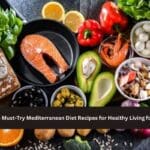7 Nutritious Foods That Are High in Vitamin D:- Vitamin D can be found in foods like egg whites, mushrooms, and some types of fish. If you don’t get enough vitamin D, changing what you eat might help.
Vitamin D has many effects on the body, including the health of bones. Low amounts of vitamin D may also make you more likely to get autoimmune diseases, according to research (1Trusted Source).
A lot of people don’t get enough D. Many people aren’t meeting the recommended levels because experts can’t agree on what those levels should be (1Trusted Source).
According to research, about 35% of people in the US don’t get enough vitamin D. There may be more shortage in some parts of the world than in others. About 80% of people in Pakistan, India, and Bangladesh are thought to not get enough vitamin D (1Trusted Source).
When we are outside in the sun, our bodies make vitamin D. Some things make it hard to get enough vitamin D this way.
7 Nutritious Foods That Are High in Vitamin D
800 IU (20 mcg) of vitamin D is the daily dose (DV). On food labels, the amount of vitamin D is shown as a proportion of the daily value (DV). This tells you how much vitamin D the food will give you every day (2Trusted Source, 3Trusted Source).
Vitamin D should come from food or pills.
Get in touch with your doctor to find out if you need a vitamin D pill in addition to food and sun. Also, they can help you find out if you are getting enough.
These seven foods are good for you and high in vitamin D.
1. Fatty fish
- A lot of people like salmon because it’s fatty and full of vitamin D.
- The Food Composition Database of the United States Department of Agriculture (USDA) says that 100 grams (3.5 ounces) of farmed Atlantic salmon has 526 international units (IU) of vitamin D, which is 66% of the daily value (4Trusted Source).
- What kind of salmon it is (wild or bred) has a big effect on how much vitamin D it has.
- Most of the time, salmon found in the wild has more vitamin D. Where the salmon is caught and the time of year will change how much vitamin D it has.
- One study found that between 556 and 924 IU of vitamin D were found in 3.5 ounces (100 grams) of salmon caught in the Baltic Sea. This is 70 to 111% of the daily value (5Trusted Source).
- Fish with a lot of fat is another good source of vitamin D. Each 3.5-ounce (100-gram) serving of halibut has 190 IU and each 100-gram serving of mackerel has 643 IU (6Trusted Source, 7Trusted Source).
2. Herring and sardines
- People all over the world eat herring. Lots of people smoke or boil it. Plus, this little fish is a great source of vitamin D.
- One 3.5-ounce (100-gram) amount of fresh Atlantic herring gives you 214 IU, which is 27% of the DV (8Trusted Source).
- If you don’t like fresh fish, pickled herring is also a good source of vitamin D. A 3.5-ounce (100-gram) dose has 113 IU, which is 14% of the DV. With 870 mg of sodium per dish, pickled herring also has a lot of salt. If you are looking to cut down on salt, this might not be the best choice (9Trusted Source).
- Salmon in a can is also a good source of vitamin D. 193 IU, or 24% of the DV, are in a 3.5-ounce (100-gram) amount (10Trusted Source).
3. Cod liver oil
Popular supplement: cod liver oil. If you don’t like fish, cod liver oil can provide missing nutrients.
- Excellent vitamin D source. It contains 56% of the DV at 450 IU per teaspoon (4.9 mL). Vitamin D insufficiency has long been treated with it. It has also been used to treat rickets, psoriasis, and tuberculosis (11, 12).
- One teaspoon (4.9 mL) of cod liver oil contains 150% of the DV for vitamin A. Vitamin A is harmful in excess. Vitamin A has a UL of 3,000 mcg. One teaspoon (4.9 mL) of cod liver oil provides 1,350 mcg vitamin A.
- Cod liver oil and other vitamin A supplements should not exceed the upper limit (11Trusted Source, 13Trusted Source).
- Additionally, cod liver oil is rich in omega-3s. Omega-3s may help the heart and reduce inflammation. Cod liver oil contains these fatty acids, along with fatty seafood. Omega-3 can be hard to get without fish (14Trusted Source)
4. Canned tuna
- A lot of people like canned tuna because it tastes good and is easy to store. Most of the time, it costs less than getting fresh fish.
- Around 34% of the DV is found in 3.5 ounces (100 grams) of canned light tuna, which has up to 269 IU of vitamin D.
- A lot of different kinds of fish contain mercury. Fish that are bigger have more mercury in them than fish that are smaller. There are different kinds of canned tuna that have different amounts of mercury.
- Light tuna in a can comes from smaller fish and has less mercury in it. There is more mercury in white canned tuna (16).
- Methylmercury can build up in your body over time. It can sometimes be very bad for your health (16, 17).
- The Environmental Defense Fund (EDF) says that you should only eat one 100-gram (3.5-ounce) amount of light tuna per week. If you’re worried about getting too much mercury, talk to your doctor about how much tuna you should eat each week (16).
See Also: 6 Mediterranean Diet Dinners That Can Help Reduce Inflammation
5. Egg yolks
- Vitamin D comes from more than fish. Whole eggs are healthy and another fantastic source.
- Eggs contain largely protein in the white and fat, vitamins, and minerals in the yolk.
- One big egg yolk contains 37 IU of vitamin D, 5% of the DV (18Trusted Source).
- Egg yolk vitamin D depends on several factors.
- Sunlight, vitamin D in chicken feed, and UV light on liquid yolk boost egg vitamin D. Pasture-raised chickens that go outside in the sun produce 3–4 times more eggs with the same feed (19).
- Eggs from vitamin D-fed chickens may provide 34,815 IU of vitamin D per 100 grams of yolk. One egg has 2.5 times the DV of vitamin D if the yolk is 17 grams (20Trusted Source).
- Eggs from outdoor-raised or vitamin D-rich chickens can help you achieve your daily needs.
6. Mushrooms
- Only fortified foods and mushrooms provide enough vitamin D without animals.
- When exposed to UV light, mushrooms generate vitamin D like people (21Trusted Source).
- Mushrooms produce D2, while animals create D3 (21Trusted Source).
- Vitamin D2 raises blood vitamin D levels, although vitamin D3 may be more effective (21Trusted Source).
- Due to UV exposure, some wild mushrooms are rich in vitamin D2. Wild mushrooms include morels. These
- mushrooms supply 17% of the DV of vitamin D in one cup (136 IU) (22Trusted Source).
- Many commercial mushrooms are dark-grown and low in D2. UV radiation boosts vitamin D in some mushrooms. One cup of UV-exposed cremini mushrooms contains 1,110 IU of vitamin D, 139% of the DV (23, 24Trusted Source).
7. Vitamin D-fortified foods
- There are not many natural sources of vitamin D, which is especially true if you are a vegetarian or if you do not enjoy eating fish.
- To our good fortune, certain dietary items that do not naturally contain vitamin D have been fortified with this essential.
Cow’s milk
Calcium, phosphorus, and riboflavin are naturally found in cow’s milk (25Trusted Source).
Vitamin D is added to cow’s milk in some places. Fortified cow’s milk in the US contains 115 IU of vitamin D per cup (237 mL), or 15% of the DV (25Trusted Source).
Soy milk
Since vegans and vegetarians can only get vitamin D from animal products, it may be harder for them to get enough (26Trusted Source).
Because of this, vitamin D and other nutrients that are usually found in cow’s milk are often added to plant-based milk alternatives like soy milk.
The amount may be different for each brand. About 100 to 119 IU, or 13 to 15% of the DV, of vitamin D can be found in one cup (237 mL) (27Trusted Source, 28Trusted Source).
Orange juice
Around 65% of people globally are lactose intolerant and 2% have milk allergies (29, 30Trusted Source).
For this reason, several businesses add vitamin D and calcium to orange juice. Breakfast with one cup (237 mL) of fortified orange juice provides 100 IU of vitamin D, or 12% of the DV (31Trusted Source).
Orange juice may not suit everyone. Acid reflux sufferers may experience worsening symptoms.
If you have diabetes, juice may raise your blood sugar. However, it’s great for treating low blood sugar.
Cereal and oatmeal
Vitamin D-fortified cereals are another option.
Fortified wheat bran flakes offer 18% of the DV of vitamin D, 145 IU per cup. Fortified crisp rice cereal includes 85 IU of vitamin D, 11% of the DV per cup (32Trusted Source, 33Trusted Source).
Not all cereals provide vitamin D. Vitamin D content should be checked on the nutrition label. Even though fortified cereals and oatmeal have less vitamin D than natural sources, they can help you get more.
Vitamin D and calcium
Your body needs vitamin D in order to absorb calcium. This is a very important part of keeping bones strong and the skeleton together.
It is very important to get enough calcium and vitamin D to keep your bones healthy and avoid diseases like osteoporosis, which causes bones to become weak and break easily (34Trusted Source).
The recommended daily allowance (RDA) for vitamin D is 800 IU per day, but it changes a little based on your age.
Between the ages of 1 and 70, kids and adults need about 600 IU of vitamin D every day. This can happen when food sources and sunshine work together. Aim for at least 800 IU (20 mcg) of vitamin D every day for adults over 70 (2Trusted Source).
Also, the RDA for calcium changes based on age. Kids between the ages of 4 and 8 need about 1,000 mg of calcium every day. Kids between the ages of 9 and 18 need about 1,300 mg every day. Between the ages of 19 and 50, adults need around 1,000 mg every day. A lot of people over 50 need 1,200 mg every day (35).







